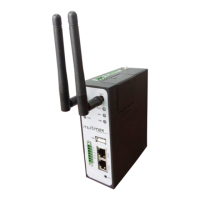!
3.17 Configuration -> Open VPN
This section allows users to set the Open VPN parameters.
Client
Enable OpenVPN Client, the max tunnel account is 3
Disable IPsec Tunnel Client.
Select from “UDP” and “TCP Client” which depends on the
application.
Enter the IP address or domain name of remote side OpenVPN
server.
Enter the listening port of remote side OpenVPN server.
Select from “tun” and “tap” which are two different kinds of
device interface for OpenVPN.
The difference between tun and tap device is this: a tun device
is a virtual IP point-to-point device and a tap device is a virtual
Ethernet device.
Select from four different kinds of authentication ways:
“Pre-shared”, “Username/Password”, “X.509 cert” and “X.509
cert+user”.
Define the local IP address of OpenVPN tunnel.
Define the remote IP address of OpenVPN tunnel.
Tick to enable NAT Traversal for OpenVPN. This item must be
enabled when router under NAT environment.
Set ping interval to check if the tunnel is active.
Restart to establish the OpenVPN tunnel if ping always timeout
during this time.
Select “LZO” to use the LZO compression library to compress the
data stream.
Select from “BF-CBC”, “DES-CBC”, “DES-EDE3-CBC”,
“AES128-CBC”, “AES192-CBC” and “AES256-CBC”.
BF-CBC: Uses the BF algorithm in CBC mode and 128-bit key.
DES-CBC: Uses the DES algorithm in CBC mode and 64-bit key.
DES-EDE3-CBC: Uses the 3DES algorithm in CBC mode and
192-bit key.
AES128-CBC: Uses the AES algorithm in CBC mode and 128-bit
key.
AES192-CBC: Uses the AES algorithm in CBC mode and 192-bit
key.
AES256-CBC: Uses the AES algorithm in CBC mode and 256-bit
key.

